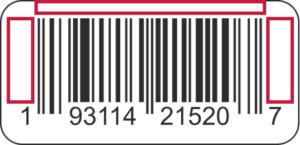Barcode Quiet Zone
The quiet zone refers to the blank space around a barcode that does not encode any data. It is a crucial aspect of barcode design and ensures accurate and reliable scanning. In the following paragraphs, we will explore the requirements and significance of the quiet zone in barcodes.

Quiet zone requirements
The quiet zone is essential for barcode scanners to properly detect and decode the barcode. It acts as a buffer between the barcode and any surrounding elements, such as text, graphics, or borders. The width of the quiet zone is typically specified by industry standards or symbology specifications. It should be free from any patterns, marks, or information that may interfere with barcode scanning. Maintaining an adequate quiet zone ensures optimal barcode readability and minimises the risk of scanning errors.
Quiet zones in barcodes
The quiet zone is located at the beginning and end of the barcode, providing a clear separation between the barcode and its surroundings. This allows the scanner to accurately identify the start and end of the barcode and ensures that no data is missed during the scanning process. The quiet zone is typically represented by a blank space that extends beyond the barcode’s bars and spaces. It is important to maintain the specified width of the quiet zone to ensure proper barcode functionality and reliable scanning results.